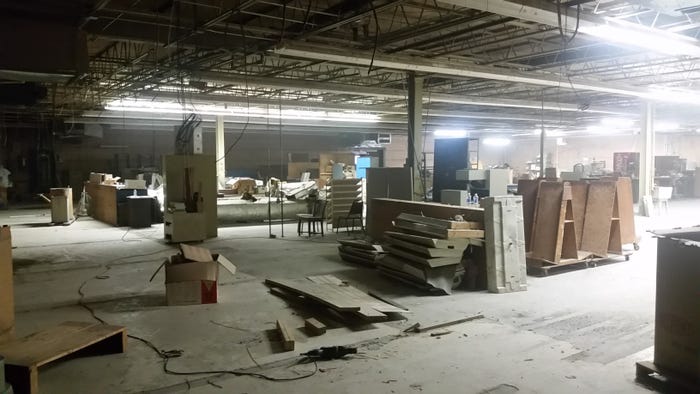Smooth Sailing With Self-Storage Conversion: Insight From a Facility Owner
Self-storage owner Erik Hemingway found development success with the conversion of a former printing plant in Wilmington, N.C. Read about the benefits of conversion, and why this type of project is often “smooth sailing” for builders and investors alike.
September 24, 2018

After five years traveling the world with his wife and six children, self-storage owner Erik Hemingway sailed into Wilmington, N.C., in 2012, choosing it as the family’s new home. He had developed his first facility in Dewey, Ariz., six years earlier, and when they left, they sold everything but the business.
A few years after settling into Wilmington, Hemingway and his wife were sitting in a downtown brewery when they spotted a former printing plant with a strong foundation and blank slate. Knowing the area lacked storage, the couple began planning a conversion project. “The building was perfect for self-storage—no windows and a loading dock,” recalls Hemingway. “The U-Haul up the street had just closed, so we decided to jump at the opportunity.” City Storage opened in February 2018 with much success, drawing customers from all over the city.

City Storage of Wilmington, N.C., before being converted to a self-storage facility
Why Convert?
The Hemingways aren’t the only ones to successfully repurpose an old building. The development trend is a great alternative to ground-up construction because conversions tend to take less time to complete and cash flow more quickly.
In addition to a shorter project timeline, there are fewer hurdles to clear, says Hemingway. This includes finding a suitable property. Construction sites in desirable locations with high visibility are getting increasingly difficult to find. In many cases, ground-up projects are also too expensive to pursue. When considering a building for conversion, visibility and accessibility are crucial. Ask yourself, “Would I build a ground-up facility at this location?”
Another advantage is zoning. Municipalities tend to be more lenient toward conversions because the building already exists and less construction is required. You may also be able to avoid extra costs because existing structures are sometimes “grandfathered” under older building codes, whereas new facilities must meet current requirements, such as energy standards. In some cases, further cost savings can occur because HVAC (heating, ventilation and air-conditioning) systems or other equipment already exist onsite. Each of these factors can influence the success of your project.
Of course, there can also be drawbacks. It's critical to know what you’re getting with an existing building. Have all systems and components inspected. You don’t want to buy a property and find out down the line you need a new roof, HVAC, electrical or sprinkler system. If this occurs, the cost advantages to your conversion may evaporate.

Demolition inside the former printing plant
Financing Considerations
Banks tend to like conversions because the shorter development timeline allows the borrower to open and break even quickly. There are also loan products available from the Small Business Administration (SBA). "The SBA loan program allowed me to start my project with less money down and see my projected cash flow," says Hemingway. Here are some benefits of an SBA program:
Lower down payment: Typically, conventional bank loans require around a down payment of 25 percent to 35 percent. SBA loans are based on cash-flow analysis and require less money up front. This allows borrowers to get started with less money down and opens the door to new owners.
Longer loan terms: SBA 7(a) loans have a 25-year fully amortizing term, whereas many conventional bank loans offer five-year terms.
Working capital: Working capital can be rolled into an SBA 7(a) loan to help bridge the financial gap until break-even occupancy and stabilization occur.
No financial covenants: SBA 7(a) loans don’t have restrictive financial covenants often found in conventional loans, such as loan-to-value and debt-service-coverage ratios.
Preferred lenders: Working with an SBA-preferred lender should make the experience less time-consuming. The right lender can help smooth the overall transaction.
Whatever source of financing you choose, finding a lender with self-storage knowledge and experience can be critical to the success of your conversion project.

The finished product
Strong Outlook
Though many believe the pent-up demand for self-storage has been met, population growth coupled with downsizing indicates customer needs will continue. “Re-urbanization in many cities is allowing for conversions,” says Hemingway. “With more people living in smaller homes, they still need a place to store their belongings.”
Keep in mind conversions are heavily influenced by the specifics of the existing structure and the dynamics of the surrounding market. Knowing the real estate value, population trends, foot traffic and other factors can help you determine how successful your project may be.
Self-storage conversions are a fitting option for owners and developers looking to launch or expand their businesses. Once you find the right building, financing will allow you to ramp up the project and take the steps toward ownership. After that, it should be smooth sailing.
Terry Campbell is general manager for the self-storage lending division of Live Oak Bank, which specializes in financing for facility acquisitions, construction, expansion, refinancing or renovation. He has more than 23 years of self-storage industry experience as a supplier as well as ownership in self-storage projects. For more information, call 910.202.6933; e-mail [email protected]; visit www.liveoakbank.com/self-storage.
About the Author(s)
You May Also Like





